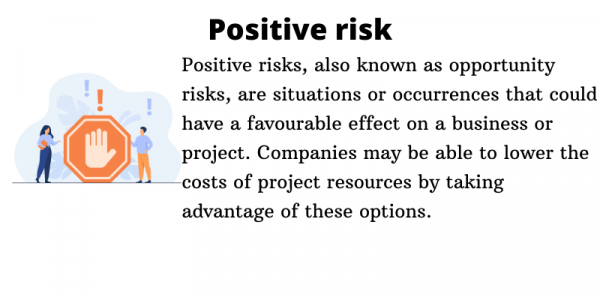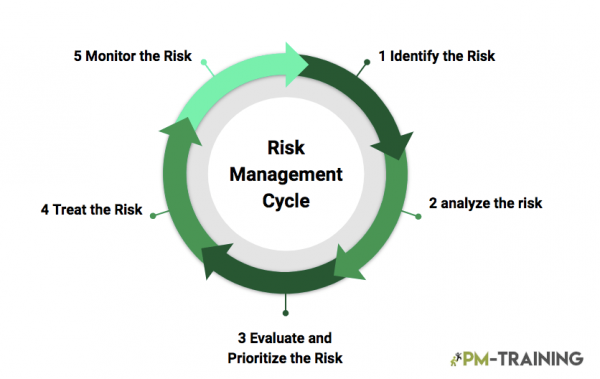Positive Risk Management is used to identify and take advantage of opportunities during a project. By taking a positive approach to risk management, organizations can improve their chances of success while also reducing their exposure to potentially damaging risks.
Project management is a complex process that involves a number of different variables. One of the most important – and often overlooked – variables is risk. Risk management is a vital part of any project management plan and can mean the difference between success and failure.
In this post, we will examine the concept of positive risk in project management. We will explore what positive risk is and how it can be used to improve the chances of success for your next project.
- Risk management in a nutshell
- Identifying a Positive Risk in Project Management
- What makes a Positive or Negative Risk in Project Management?
- How to productively respond to Positive Risk during a Project?
- Examples of Positive Risk
- What is Positive Risk in Project Management?
- What are examples of Positive Risk?
- What are the differences between Positive and Negative Risk in Project Management?
Risk management in a nutshell
To understand what is a positive risk first we need to understand what risk management implies during the lifecycle of a project.
Risk management is the process of identifying, analyzing, and responding to risks. It is an ongoing process that should be incorporated into every aspect of an organization.
Here’s an image of how the risk management cycle works:
Risk management is the process of identifying, analyzing, and responding to risks. It is an ongoing process that should be incorporated into every aspect of an organization.
The benefits of risk management are many.
- It can help organizations avoid or mitigate losses, improve decision-making, and increase profitability.
- It can also help organizations become more resilient and adaptable to change.

Identifying a Positive Risk in Project Management
Organizations must be able to identify and assess risks, as well as develop and implement effective responses.
Risk is defined as an uncertain event or condition that, if it occurs, will have a positive or negative effect on a project’s objectives.
While all risks are not negative, all risks should be managed in order to minimize their impact on the project and sometimes, to take advantage of it.
Positive risk identification is vital to the success of any project. By understanding and identifying positive risks, project managers can take steps to mitigate these risks and ensure that they do not have a negative impact on the project.
There are a few key things to look for when identifying positive risks.
- First, look for risks that have the potential to improve the project in some way. These risks can be opportunities to make the project more efficient or effective.
- Second, look for risks that are manageable and within the control of the project manager.
- Finally, look for risks that are relevant to the project at hand. These risks should be directly related to the project goals and objectives.
By following these guidelines, project managers can identify positive risks that can be leveraged to improve the project.
What makes a Positive or Negative Risk in Project Management?
Risk is inherent in all projects, but it can be classified as either positive or negative. Positive risk is often referred to as opportunity, while negative risk is typically called threat. Both types of risk can have a major impact on a project, but they need to be managed in different ways.
Positive risks are those that have the potential to improve your project in some way. They should be encouraged, as it can lead to new opportunities and discoveries.
- For example, a new technology might become available that could improve your project’s efficiency.
Identifying positive risks early on can help you take advantage of them and improve your project’s chances of success.
Negative risks, on the other hand, are those that could potentially harm your project. They should be minimized as much as possible, as it can often lead to problems and setbacks
- For example, a key supplier might go out of business, which could delay your project.
In order to successfully manage risk in a project, it is important to understand the difference between positive and negative risk. By doing so, you can put in place the proper strategies to ensure that your project is successful.

How to productively respond to Positive Risk during a Project?
When a risk is identified as being positive, it means that it has the potential to improve the project in some way. While this may seem like a good thing, it’s important to remember that all risks should be treated with caution.
There are a few ways to approach positive risks:
- Accept the risk and plan for it accordingly. This means that you’ll need to put controls in place to mitigate the potential negative outcomes.
- If you identify a positive risk, you should assess whether it’s something you can take advantage of. If so, you should create a plan to exploit the opportunity. If not, you should put a contingency plan in place to mitigate the risk.
- Defer the decision on whether to accept the risk. This gives you time to gather more information and make a more informed decision.
- Transfer the risk to another party. This is often done by insurance or by contracting out the work to another company.
No matter how you choose to approach positive risks, it’s important to remember that they should be treated with the same level of caution as any other
If you identify a positive risk, you should assess whether it’s something you can take advantage of. If so, you should create a plan to exploit the opportunity. If not, you should put a contingency plan in place to mitigate the risk.

Examples of Positive Risk
Positive risks are risks that have the potential to turn into opportunities.
- For example, a positive risk might be that a new technology you’re using turns out to be more successful than you expected and that can be introduced to the project team by helping them to be more successful.
- Another example of positive risk is choosing to work with new or unproven vendors. While there is always the potential for problems with new vendors, there is also the potential for them to exceed your expectations and deliver a great product or service.
Other examples when risks arise and you can take advantage of them can be when:
- A change in the project scope where a new introduced policy can benefit your project
- Adding additional resources to the project your team was not expecting
- A change in the project schedule that will allow your teeam for more tim
What is Positive Risk in Project Management?
In project management, positive risks are those risks that have the potential to result in positive outcomes for the project. While all risks have the potential to result in negative outcomes, positive risks have the potential to result in positive outcomes. They should be actively managed and monitored, as they can result in increased project success
What are examples of Positive Risk?
Some examples of positive risks in project management include: The risk that a new technology will be successfully implemented and will result in increased efficiency. The risk that a new product will be well-received by the market and will result in increased sales. The risk that a new marketing campaign will be successful and will result in increased brand awareness
What are the differences between Positive and Negative Risk in Project Management?
The main key differences are that positive risks are often seen as more desirable because it has the potential to improve the project outcome. While negative risks are often seen as less desirable because it has the potential to worsen the project outcome.
